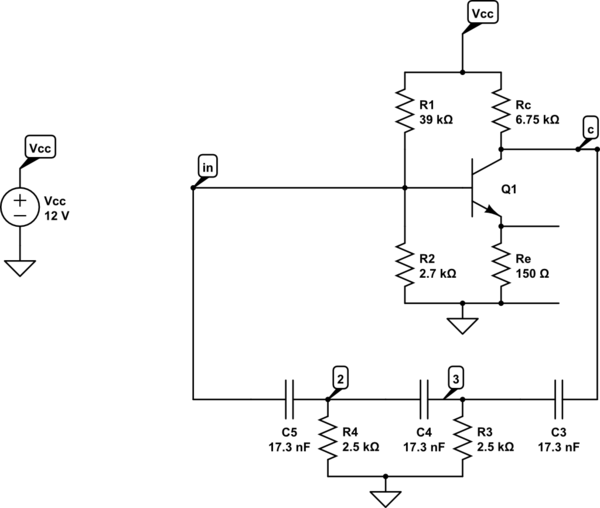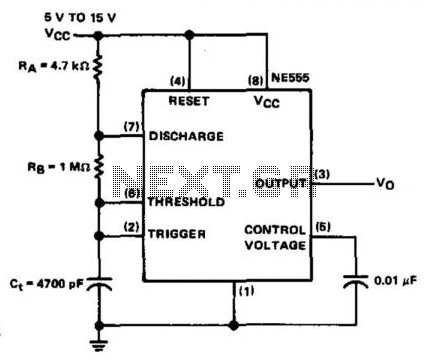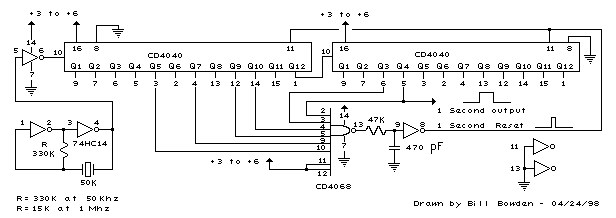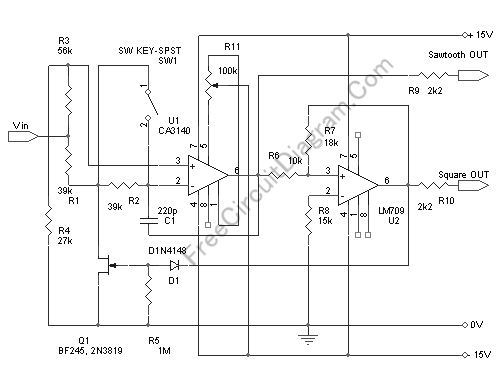
Relaxation Oscillator
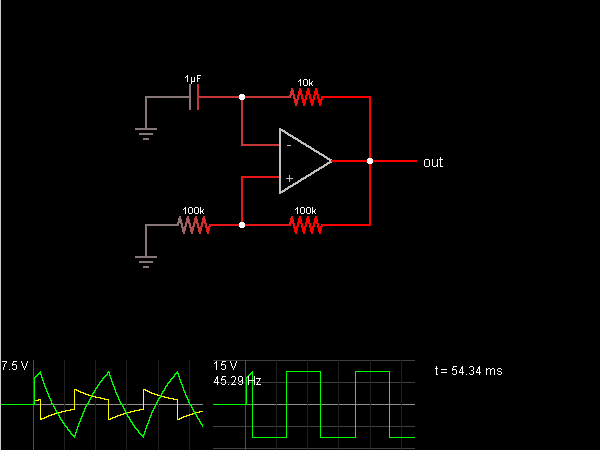
This circuit is an oscillator that generates a square wave. The operational amplifier (op-amp) begins with its two inputs in an undefined state, starting with the non-inverting input slightly higher than the inverting input. The op-amp significantly amplifies this difference, driving its output to the positive power supply voltage, reaching its maximum output of 15 V in this configuration. Two 100k resistors function as a voltage divider, setting the non-inverting input to half the output voltage, approximately 7.5 V. Since the inverting input is grounded, it is lower than the non-inverting input, maintaining the op-amp output at 15 V. Current flows from the op-amp output to ground through a capacitor, charging it. Once the capacitor charges to slightly above 7.5 V, the inverting input becomes higher than the non-inverting input, causing the output to switch to -15 V. This transition brings the non-inverting input down to -7.5 V.
The described oscillator circuit utilizes an operational amplifier configured in a feedback loop to produce a square wave output. The circuit operates by exploiting the characteristics of the op-amp and the charging and discharging behavior of the capacitor. Initially, when the output is at 15 V, the voltage divider formed by the two 100k resistors sets the non-inverting input to 7.5 V. The inverting input, being grounded, ensures that the op-amp remains in a high state.
As the capacitor charges through the op-amp's output, it accumulates voltage until it reaches a threshold slightly above 7.5 V. At this point, the op-amp's output transitions from 15 V to -15 V, effectively flipping the output state and causing the non-inverting input to drop to -7.5 V. This rapid change in output voltage creates the square wave characteristic of the oscillator.
The frequency of oscillation can be adjusted by varying the capacitance of the capacitor or the resistance values of the resistors in the feedback loop. The design allows for a stable oscillation as long as the op-amp operates within its specified voltage and current limits. This oscillator circuit can be utilized in various applications, such as clock generation for digital circuits, tone generation in audio applications, or as a basic signal generator in testing scenarios. Proper consideration of component tolerances and power supply stability is essential for reliable operation.This circuit is an oscillator that generates a square wave. The op-amp starts with its two inputs in an unknown state; let`s say it starts with + slightly higher than. The op-amp greatly amplifies this difference, bringing its output to the op-amp`s positive power supply voltage, its maximum output (15 V in this case).
The two 100k resistors a ct as a voltage divider which put the + input at half the output voltage, or 7. 5 V. The input is at ground, lower than the + input, so the op-amp output stays at 15 V. Current flows from the op-amp output to ground through the capacitor, charging it. As soon as it charges to slightly more than 7. 5 V, the input is now higher than the +, and so the output flips to -15 V. This brings the + input to -7. 5 V. 🔗 External reference
The described oscillator circuit utilizes an operational amplifier configured in a feedback loop to produce a square wave output. The circuit operates by exploiting the characteristics of the op-amp and the charging and discharging behavior of the capacitor. Initially, when the output is at 15 V, the voltage divider formed by the two 100k resistors sets the non-inverting input to 7.5 V. The inverting input, being grounded, ensures that the op-amp remains in a high state.
As the capacitor charges through the op-amp's output, it accumulates voltage until it reaches a threshold slightly above 7.5 V. At this point, the op-amp's output transitions from 15 V to -15 V, effectively flipping the output state and causing the non-inverting input to drop to -7.5 V. This rapid change in output voltage creates the square wave characteristic of the oscillator.
The frequency of oscillation can be adjusted by varying the capacitance of the capacitor or the resistance values of the resistors in the feedback loop. The design allows for a stable oscillation as long as the op-amp operates within its specified voltage and current limits. This oscillator circuit can be utilized in various applications, such as clock generation for digital circuits, tone generation in audio applications, or as a basic signal generator in testing scenarios. Proper consideration of component tolerances and power supply stability is essential for reliable operation.This circuit is an oscillator that generates a square wave. The op-amp starts with its two inputs in an unknown state; let`s say it starts with + slightly higher than. The op-amp greatly amplifies this difference, bringing its output to the op-amp`s positive power supply voltage, its maximum output (15 V in this case).
The two 100k resistors a ct as a voltage divider which put the + input at half the output voltage, or 7. 5 V. The input is at ground, lower than the + input, so the op-amp output stays at 15 V. Current flows from the op-amp output to ground through the capacitor, charging it. As soon as it charges to slightly more than 7. 5 V, the input is now higher than the +, and so the output flips to -15 V. This brings the + input to -7. 5 V. 🔗 External reference
